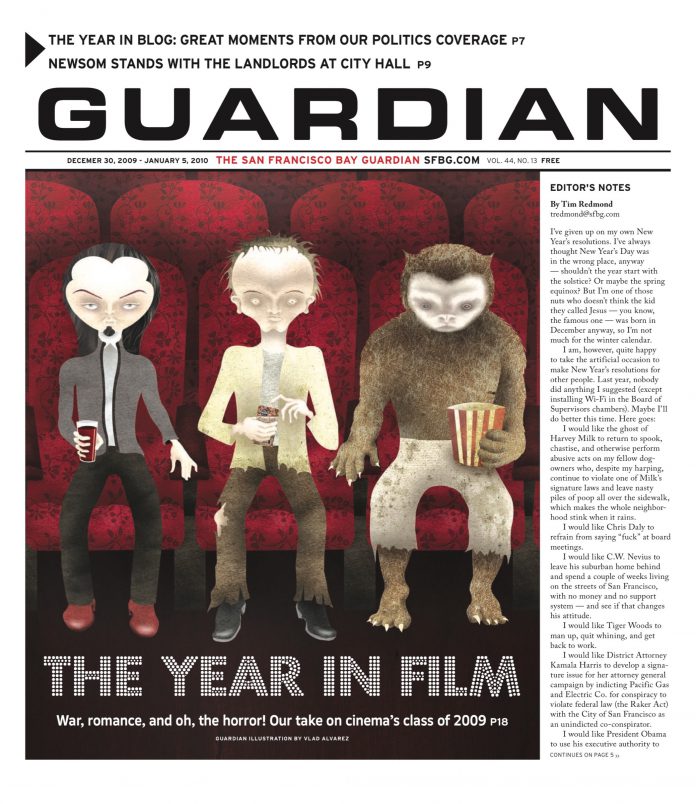YEAR IN FILM “We could live like this forever.” Josephine, the serious young woman in Claire Denis’ gorgeous chamber drama 35 Shots of Rum, whispers this line to her father while they’re camped out on the beach. It’s unclear, however, whether she’s referring to this particular sandy spot or the rituals of home and work that structure the film. As with Chris Chong’s remarkable short, Block B, 35 Shots of Rum (a ritual in the title itself) is set in a superficially unattractive apartment complex. Beyond the concrete is an intricate network of human relations. In the republic of cinema, the Denis film descends from that great poet of routine life, Yasujiro Ozu. Daily rituals dilate exposition and emotion; the safe enclosure of home unfolds in time.
Many of the most indelible, mood-lifting moments of my sporadic year of film-going arrived in the deepened presence of ritual: two shots of espresso, in separate cups; dismantling a bomb; shaving radishes; sheering sheep; the ecstatic sweat of a Lightning Bolt concert; the murderous talk surrounding a stand-up act. The Limits of Control cracks a zen joke out of those scenes that take us to edge of plotlessness; The Hurt Locker posits them at the lip of death. Every genre has its rites, but ritual is roped off by an extraordinary and transformative act of concentration: not so much a slice of life, as the heart of it.
To begin with an imperfect example, take Funny People. The informal joke workshops are the best thing about Judd Apatow’s chef-d’oeuvre by some distance — a romantic plot is deathly flat next to the backstage lollygagging. Likewise, for all The Hurt Locker‘s amazing mappings of harm’s way and its rigorous equation of work and action, Kathryn Bigelow’s film sags in the bland passages earmarked for character development. However momentarily, both movies put the blockbuster through paces.
Rituals, as I’ve described them, give us time to think and feel, and thus crop up with greater frequency in experimental work (ritual makes the documentary-fiction divide matter less). In Heddy Honigmann’s Oblivion, political history flows from her interview subjects’ ingenious livelihoods. Representatives of the service class relay personal and national narratives at work, their gestures embodying resilience and wisdom beyond the bounds of political rhetoric.
A clarifying admiration of labor also animates Sweetgrass, Ilisa Barbash and Lucien Castaing-Taylor’s near-wordless immersion into a final sheep drive across Montana. Recorded with ethnographic grit and uncommon lyricism, the film counterpoints detailed sound recordings with monumental, temporal landscape photography. A peculiar mix of estrangement (the implacable animal stare) and intimacy (the last cowboys’ muttered curses), Sweetgrass packages a dying way of life as a wayward phenomenological experience — the ritual as haunting.
Rendered as cinema, there is every possibility that ritual will make for a trance. Ben Russell actively cultivates this state in his Black and White Trypps series. Excerpts of all six of these shorts, as well as a 10-minute slice of Russell’s acclaimed feature debut, Let Each One Go Where He May, are available on his Vimeo site, but seeing the third installment in 35mm at the Pacific Film Archive raised the stakes considerably. In it, Russell sends a beam of light into the teenage sprawl of a Lightning Bolt show, creating a visible field barely broad enough for one or two wild faces. The crowd’s pulse makes for an ephemeral, twisting portrait. Projected on the big screen, the baroque expanse of sound and black gave the mined portraits a distinctly transcendent aura. Russell’s Warhol-worthy idea locates solitude in collectivity and authenticity in performance. The 11-minute film also invites us to reconsider the coordinates of that other common ritual that brings us alone together in the dark — cinema.

